
Pros:
– Performance
– Display
– Quad speakers by JBL
– Premium looks, lightweight design
– Great value for money
Cons:
– Rear camera could have been better
– Is let down by Android’s tablet ecosystem
Rating: 3.75/5
Price:
– Tab P11 Pro (2nd Gen) + Precision Pen 3: Rs 39,999
– P11 Pro Keyboard: Rs 5,499
It seems that Lenovo has cracked the formula of making really good Android tablets, which, if you look at offerings from other manufacturers, you will realise, is no easy feat. The newest offering from their lineup, the Lenovo Tab P11 Pro (2nd Gen), which was recently launched in India is surely going to make it clear to everyone why Lenovo has a stronghold over the Android tablet market, especially in India.
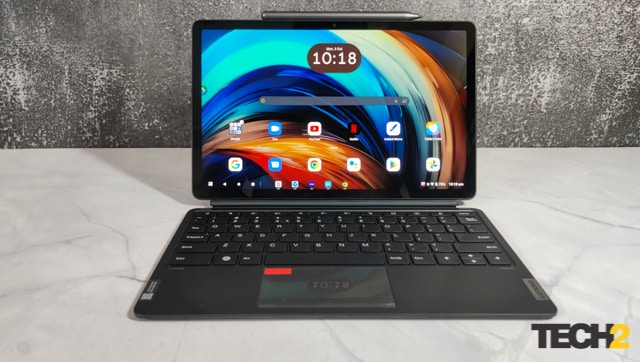
Android tablets tend to be a hit or a miss. In most cases, manufacturers don’t really get that users in India, often use tablets as a substitute for a laptop. Hence, performance is given a very high priority. Thankfully, Lenovo understands that. Perhaps that is why, the Tab P11 Pro (2nd Gen) ticks all the right boxes for anyone who is looking for a solid Android tablet that can be used not just for content consumption, but for some serious productivity as well.
Design and Construction
The Lenovo Tab P11 Pro (2nd Gen) is a very elegant-looking machine that is pretty stylish as well. Starting at the rear, you get a two-toned back panel which has a glass-like finish and minimal logos of Lenovo and Dolby. The rear panel also has a magnetic portion which holds the included Precision Pen 3.
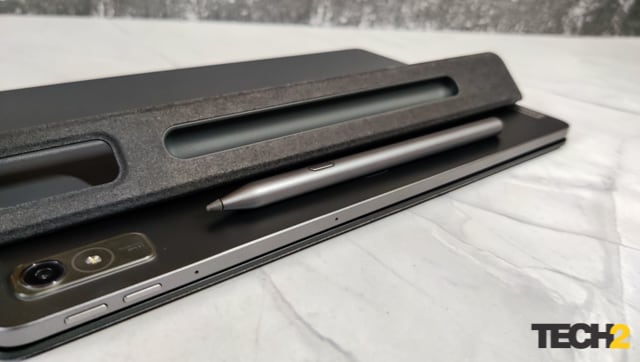
The rear camera housing is very minimal and has a very little bump. When used with the leather cover for the rear, the camera hump goes into an even deeper recess. The bottom portion of the leather cover can be bent outwards which doubles up as a stand.
Our test unit came with a rear leather cover, as well as the optional ThinkPad keyboard cover as well. Both, the rear cover and the keyboard folio snap onto their correct places thanks to the magnets in the tablet.
Coming to the buttons, you get the power button at the top, along with the SIM tray, and a pair of speakers. On the right-hand side, you get a pair of volume rockers. On the left, we see a couple of dimples to hold the keyboard folio in place and a couple of keyboard connectors. At the bottom, we see a USB-C port and another pair of speakers.
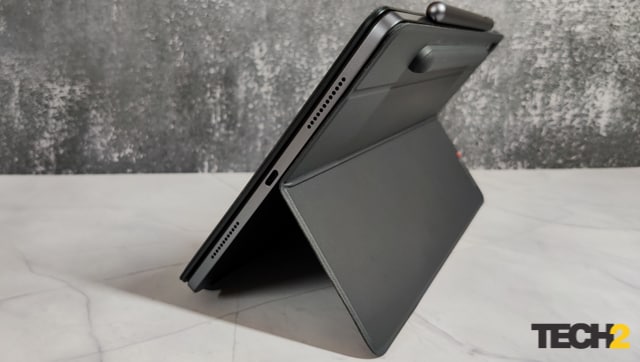
On the front, you don’t get to see any notch or a punch-hole cutout. Instead, you get some rather thin bezels. On the right side, you get to see the front-facing camera which stays hidden in the bezel.
At no point in time during our testing did we get the feeling that the tablet is flimsy. The Tab P11 Pro (2nd Gen) is really built well and feels very solid to hold. This again is a very impressive feat considering that the tablet weighs in at about 480 grams, without the folio and the Precision Pen.
Daily driving the tablet
Let’s start with the display. You get an 11.2-inch 2.5K OLED display with a resolution of 2560X1536 pixels and an aspect ratio of 15:9. The panel gets certifications from HDR, Dolby Vision, HDR10+ and covers 100 per cent of the DCI-P3 colour gamut. The panel also has a refresh rate of 120Hz with a touch sampling of 360Hz. It also supports up to 600nits of brightness.
What all of this translates to is amazing picture quality, with razor-sharp images, crisp and clean colours, proper saturation and contrast levels – basically, you get a very lively image, without going overboard. Naturally then, content consumption, whether it is on Netflix, or YouTube is just great.
The screen is immersive enough to have a great time watching videos, and you can go on for hours binge-watching one show or movie of your choice after the next. Good thing that the Tab P11 Pro (2nd Gen) comes with a TÜV Rheinland Full Care Display Certification that makes it less harsh on the eyes.
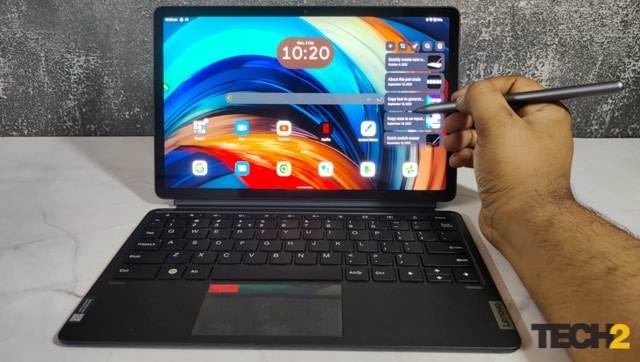
Lenovo is bundling the Tab P11 Pro (2nd Gen) with the Precision Pen 3 for free and is offering the ThinkPad Keyboard folio for a price of Rs 5,499. We seriously recommend you get the keyboard with the tablet – you will just have a much better and more rounded experience.
The Precision Pen 3 goes really well with the Tab P11 Pro (2nd Gen). It is able to register the changes in pressure, and reflects that on the screen when you’re doodling, or using it to create digital art. There’s almost no latency between the pen and the tablet, so you get a very realistic experience.
The keyboard, on the other hand, makes using the tablet as a laptop is much more convenient, and truly allows you to milk the multitasking potential of the tablet. Plus, typing on the keyboard is pretty straightforward, and might I say, enjoyable. The only complaint we have against the keyboard is that it isn’t backlit, but that’s us nitpicking.
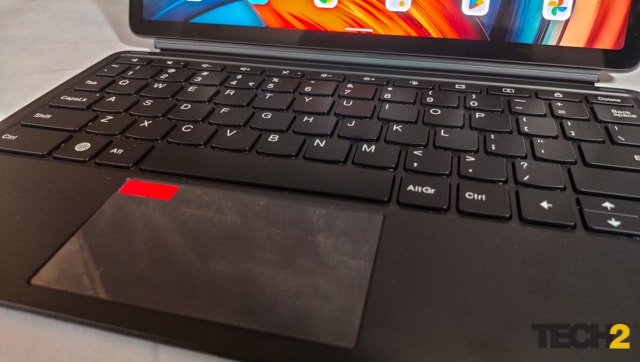
Lenovo has done a pretty solid job with the sound system also in the Tab P11 Pro (2nd Gen). You get a set of quad speakers that get pretty loud and do not distort at high volume. The sound from the tablet is more than enough to fill up a large-ish room during a party. After all, they have been made by JBL and have been optimised by Dolby Atmos. It goes without saying that content consumption is phenomenal as well. Do keep in mind that you don’t get a 3.5mm jack. You will need to use a 3.5mm-to-USB-C dongle to listen to your wired headphones or go for a BlueTooth option.
Coming to the cameras, you get a 13MP sensor at the rear and an 8MP sensor at the front. The rear cameras are not bad exactly but don’t expect the images or the videos from the rear camera to blow you away – if you’re in a quick fix, and just need something to take photos, it will get the job done. The front camera again is adequate for your Zoom or Google meet meetings. Having said that it does a pretty great job in recognising faces for facial unlock – it is quick, fast, and doesn’t miss that often.
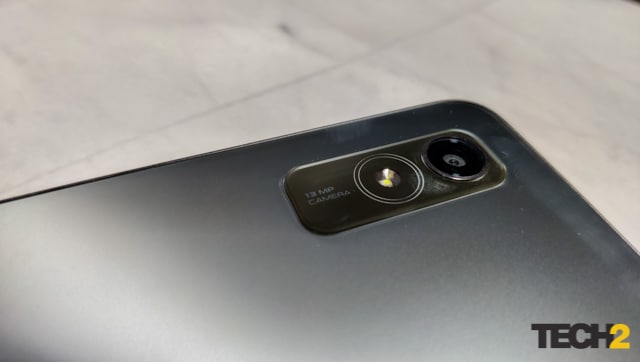
Coming to the software side of things, we get the usual idiosyncrasies of using Android L. The Lenovo Tab P11 Pro (2nd Gen) comes with Android 12L. As we mentioned earlier, to get the most out of the multitasking features of the tablet, you need to have the ThinkPad keyboard accessory. Switching between apps, is buttery smooth, even when you have multiple apps and multiple windows opened up. On Google, chrome, we were able to open up about 20 tabs with various other applications going on, and the tablet still did not show any signs of slowing down. Switching between the keyboard, and the Precision Pen 3, was again, very smooth.

However, there are some issues. As hard as Google tries, there are some inherent issues with Android builds for tablets. Yes, there are some features that Android’s Tablet version has over iPadOS, but there is a reason why Apple dominates the tablet market space. The Android tablet app ecosystem is very rough. Some of the apps that I use regularly have not been optimised for Android Tablets. This results in some jittery scaling, and some weird orientation issues at times. This, in turn, hurts devices like the Tab P11 Pro, even though they clearly have the hardware to go the distance.
Lenovo says that it will support the Tab P11 Pro (2nd Gen) for the next 2 generations of Android, that is until Android 14, and will provide security updates for 3 years, so that’s a major plus point for them.
Performance
Now, let’s take a look at the performance. The Tab P11 Pro (2nd Gen) comes with a MediaTek Kompanio 1300T chipset which has been paired with a Mali G77 MC9 GPU. Our test unit had 8GB of LPDDR4X RAM and 256GB of UFS 3.1 storage. Lenovo says that the reason why they went for the MediaTek Kompanio 1300T SoC was to keep the device 5G ready and to give it the chops that would be needed for gaming. And it shows.
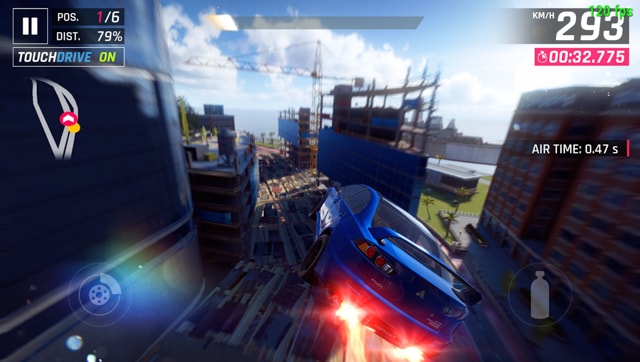
In NFS: No Limits we were getting 120 fps at the best settings possible, and in Apex Legends, we were consistently getting over 95 fps.
It performed really while rendering photos in Adobe Lightroom and while exporting videos on Adobe Premiere Rush. The MediaTek Kompanio 1300T held up well against benchmarks as well.
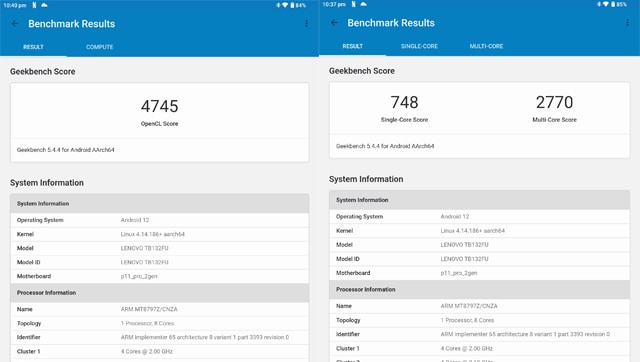
In Geekbench, Tab P11 Pro (2nd Gen) had an OpenCL score of 4745. In single-threaded performance, it scored 748 and in multi-threaded tests, it scored 2770. In 3D Mark’s Wild Life Stress test, its best loop score was 3028, and its lowest loop score was 2192, which, is pretty impressive, and shows that it can take on sustained loads.
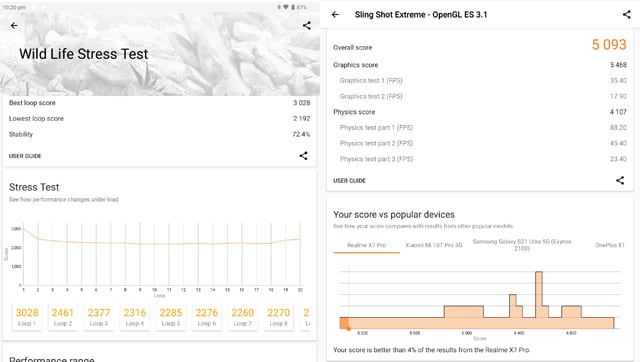
During stress tests and prolonged gaming sessions, it did heat up by just a little bit, but that’s to be expected. At no point did the device heat up in a way that should be concerning.
Battery
The 8000mAh battery that the Tab P11 Pro (2nd Gen) comes with is pretty solid. Lenovo is using a pretty smart battery management system that does not throttle performance just to give you a few extra hours of usage. I got about 14-15 hours of battery life which included a lot of time spent on YouTube, Netflix, and a few long gaming sessions.
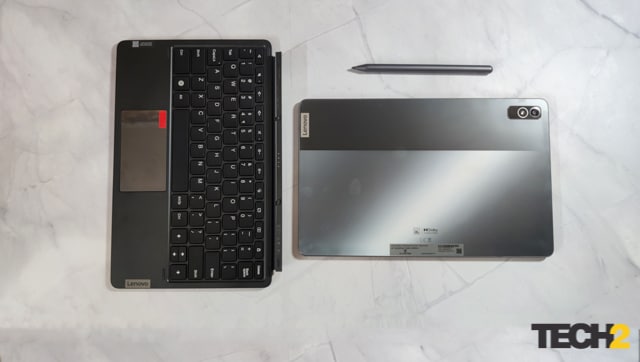
In regular, day-to-day office usage, when using the Tab P11 Pro (2nd Gen) comes with the Precision Pen and Keyboard, we got just shy of 16 hours of battery life. The best part, however, is how the device charges. During our testing, we found that it goes from 10 cents to 100 per cent, in just over 50 mins, which, for a tablet, is seriously impressive.
Verdict
If you’re looking for an Android tablet only to consume content, then there are cheaper alternatives that do provide a somewhat similar visual and aural experience. However, if productivity and gaming are important considerations, then this ‘THE’ tablet that you should be looking at. Under Rs 50,000, there are very few options that hold a candle to the Lenovo Tab P11 Pro (2nd Gen).
I seriously wouldn’t hesitate to recommend this tablet to anyone, especially if they are looking for something compact and don’t want to carry a full-sized laptop around with them. The Lenovo Tab P11 Pro (2nd Gen) is what Chromebooks should have been all along, and what we hope the upcoming Pixel Tablet will be, at least in spirit.
